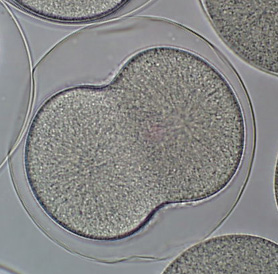|
The membrane depolarization acts as
the fast blockto
polyspermy (fertilization by
more than one sperm); it is though to interfere with
electrostatic interactions between surface proteins of the
sperm and egg (Fig. 7.22). Polyspermy
is bad because, in addition to the extra set of chromosomes,
a sea urchin sperm donates a centriole. The presence of
additional centrioles during the first cell division will
result in additional cleavage furrows and incorrect
partitioning of the chromosomes (Fig. 7.21).
Ca++
ions are released from the endoplasmic reticulum in a wave
beginning a the sperm binding point (Fig. 7.25). The wave of
Ca++ induces the fusion of a set of exocytic vesicles (known
as the cortical granules) with the plasma
membrane (Fig. 7.24). The
contents of the cortical granules, released into the space
between the vitelline membrane and the plasma membrane,
include a trypsin-like protease that clips protein "posts"
anchoring the vitelline membrane and removes the
sperm-binding sites. The cortical granules also release
mucopolysaccharides (carbohydrates) that absorb water and
cause the vitelline membrane to expand and become the
fertilization envelope; this is the
slow
blockto polyspermy (Fig.
7.23).

The
sperm and egg plasma membranes also
fuseand the sperm nucleus
enters and fuses with the egg nucleus. The wave of Ca++ and
the rise in intracellular pH activate the
metabolismof the
fertilized egg (Fig. 7.27).
The
union of sperm and eggs creates single cell,
thezygote, which gives
rise to a new organism through
the process of embryogenesis. The formation of a new
organism requires both
morphogenesis(the
creation of form) and cell
differentiation.
In most
animals, embryogenesis can be divided into three major
stages:
(1)
Cleavage, in which rapid cell divisions divide the
mass of the zygote into many
cells and establish the basic embryonic axis;
(2)
Gastrulation, in which the gut is formed and the
embryo becomes multilayered;
and
(3)
Organogenesis, in which the major organ systems are
formed. The embryo cannot feed until it develops a digestive
system, so all of the nutrition that it will need must be
packed in the egg. This is true in the sea urchin, but the
food material (yolk) does not disrupt the partitioning of
cytoplasm, known as cytokinesis, after each cell division.
This pattern of cell division (complete and equal) is known
as holoblastic
cleavage(Fig. 8.5).

|
